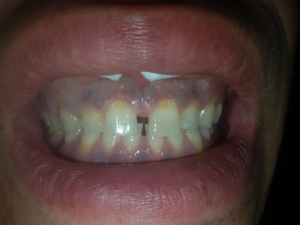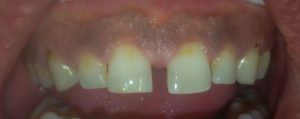Case Study: A Persistent Gingival White Lesion Treated with Acquolab
Introduction
Candida is a major human fungal pathogen causing infectious conditions predominantly in the elderly and immunocompromised hosts. Although Candida resides as a member of the oral indigenous microbiota in symbiosis, some circumstances may cause microbial imbalance leading to dysbiosis and resultant in oral candidosis. The diagnosis of oral candidosis is essentially clinical and based on the recognition of the lesions by the oral pathologist. Clinically, there are a number of different types of oral candidosis that could involve oral mucosa and lips. Iron and vitamin deficiencies, consumption of carbohydrate-rich diets, long-term drug therapy such as immunosuppressants and antibiotics, gastrointestinal disorders, immunodeficiency status such as human immunodeficiency virus (HIV) infection are a few among a plethora of factors that predispose to the lesion. Therefore the choice of therapy is guided by the type of candidosis. Nystatin and amphotericin b have been the first choice of treatment for years, and the use of Fluconazole oral solution was successfully proposed for the treatment of oropharyngeal candidosis. Among systemic drugs proposed for the treatment of oral candidosis are Fluconazole, Itraconazole, Voriconazole.
The emergence of drug-resistant strains and frequent recurrence of the disease in affected individuals are increasing challenges in antifungal therapy. The use of probiotics, prebiotics, and synbiotics have actually been proposed as an alternative antifungal therapies.
Photodinamic therapy is also proposed in the literature to treat oral candidosis, but there are only studies on animals or in vitro studies.
Another recent study evaluated the effectiveness of ozonated water in the treatment of oral candidosis, when compared with topical clotrimazole. Based on the results of this study, there was gradual but significant reduction in candida CFU—especially in the group treated with ozonated water. We describe a case report of a male patient with gingival candidosis treated with a new type of device that produces ozonated water.
Case Presentation
A 42-year-old male smoker patient went to our private practice for a tartar ablation. We observed the presence of a white film on the upper gingiva not easily removable (fig. 1). The patient explained to us that it had been present from several months. The anamnesis was negative for systemic pathologies, but the oral hygiene was very poor, and he smoked about 20 cigarettes a day. A diagnosis of gingival candidosis was made. We decided to treat the lesion with the use of Acquolab, using a smaller nozzle and with using the second program for the water and for the ozone regulation, with 2 cycles of 1 minute each.
The lesion disappeared immediately after treatment (fig 2). At the next follow-up visit one month later, the gingival tissue appeared free of the white film lesion.
 Figure 1
Figure 1
 Figure 2
Figure 2
Discussion
Different protocols in literature have been proposed for treatment of oral candidosis. The effectiveness of nystatin solution is undiscussed but its use is connected with a series of collateral effects. The unpleasant taste and prolonged pattern compromise treatment compliance by the patient; furthermore, the poor adherence of the nystatin to the oral mucosa and thus the quick ingestion of the suspension reduce efficiency of this therapy. Some studies have reported the citotoxicity of nystatin in the host cell. On the other hand, Flucanozole and Miconazole prove to be also very effective; nevertheless, they are contraindicated in all cases treated with some kind of medicines, such as Warfarin. This is because of their mechanism of inhibition of the enzyme cytochrome P-450, which affects the clearance of certain drugs.
The use of probiotics, prebiotics and synbiotics in the therapy of oral candidosis has not been well studied. The majority of studies have indicated the use of probiotics for the treatment of two major dental diseases: dental caries and periodontitis. Regarding the use of probiotics for oral candidosis, the literature data are sparse and concluded that their result have shown that effect was not significant or was small without an improvement in the mucosal symptom. It has also been proposed the use of probiotics and prebiotics fusion products or “synbiotics” for the intestinal tract microbiota. However, the use of synbiotics for the oral microbiota has not been well studied. It is important to understand the limitations associated with the oral application of synbiotics. Probiotic bacteria are not able to easily colonize adult oral cavity. Therefore, it appears that synbiotics are more effective for oral applications than probiotics alone. However, it is important to consider the risk of dental caries while applying lactic acid bacteria in the oral cavity. Lactobacilli have long been considered to be one of the cariogenic bacteria present in dental plaque—in fact, they are hardly detected in the oral cavity of caries-free individuals.
Recently antimicrobial photodynamic therapy (PDT) has been proposed as an alternative to antibiotics for the treatment of microbial infections. This method is based on the activation of a photosensitizing agent by a specific wavelength light that corresponds to maximum absorbance by the substance. It results in the production of free radicals, singlet oxygen, and other reactive oxygen species, which have a toxic effect on bacterial cells, leading to cell death without causing harm to the host. In the literature, there are only studies on animals or in vitro studies.
Different studies have been conducted on the effectiveness of essential oil and ozonated water. Ozone has been considered for its various antimicrobial, antihypoxic, analgesic, and immunostimulating effects on biological systems. It is commonly used in the treatment of external ulcers, skin lesions, arterial circulatory disorders, immunodeficiency states, fungal infections, etc. When compared with topical clotrimazole, ozone therapy seems to be more effective in reducing the Candidal species count. Some studies have reported that essential oils may be proposed for treatment of oral candidosis because of their antimicotic properties—in particular for the presence of thyme and clove. The results of a previous study have been shown that essential oil gel of plant Z is able to reduce the palatal erytema. Its effectiveness if compared with myconazole cannot be considered significantly better than myconazole, which was also mycologically more effective. Moreover, it is important to consider that the use of essential oils is associated to an important adverse effect: their strong aromatic and corrosive action on oral mucosae rendered them irritant and unsafe to be used in their crude form. There is also a study on the efficacy of Malaleuca against candida colonies, but is tested on animals.
In this case, we have tried to treat the condition without topical therapy but with a single session of cleaning tongue with ozonated water performed with AcquoLab. The use of ozonated water for the treatment of oral infections is successfully documented in the literature. The ozonated water is also successfully analyzed for the treatment of periodontal disease. Some authors have tested this medication in patients with orthodontic therapy to reduce the bacterial load. An in vitro study demonstrated the activity of ozonated water on Streptococcus mutans and Enterococcus faecalis, and these results suggest that ozonated water application may be useful for endodontic therapy. In a recent study, researchers demonstrated effectiveness in the reduction of CFU values in oral candidosis. The successes of ozonated water therapy against various bacterial and mycotic species in the various fields of oral medicine and also the absence of adverse effects have led us to propose this device in the care of oral candidosis.
